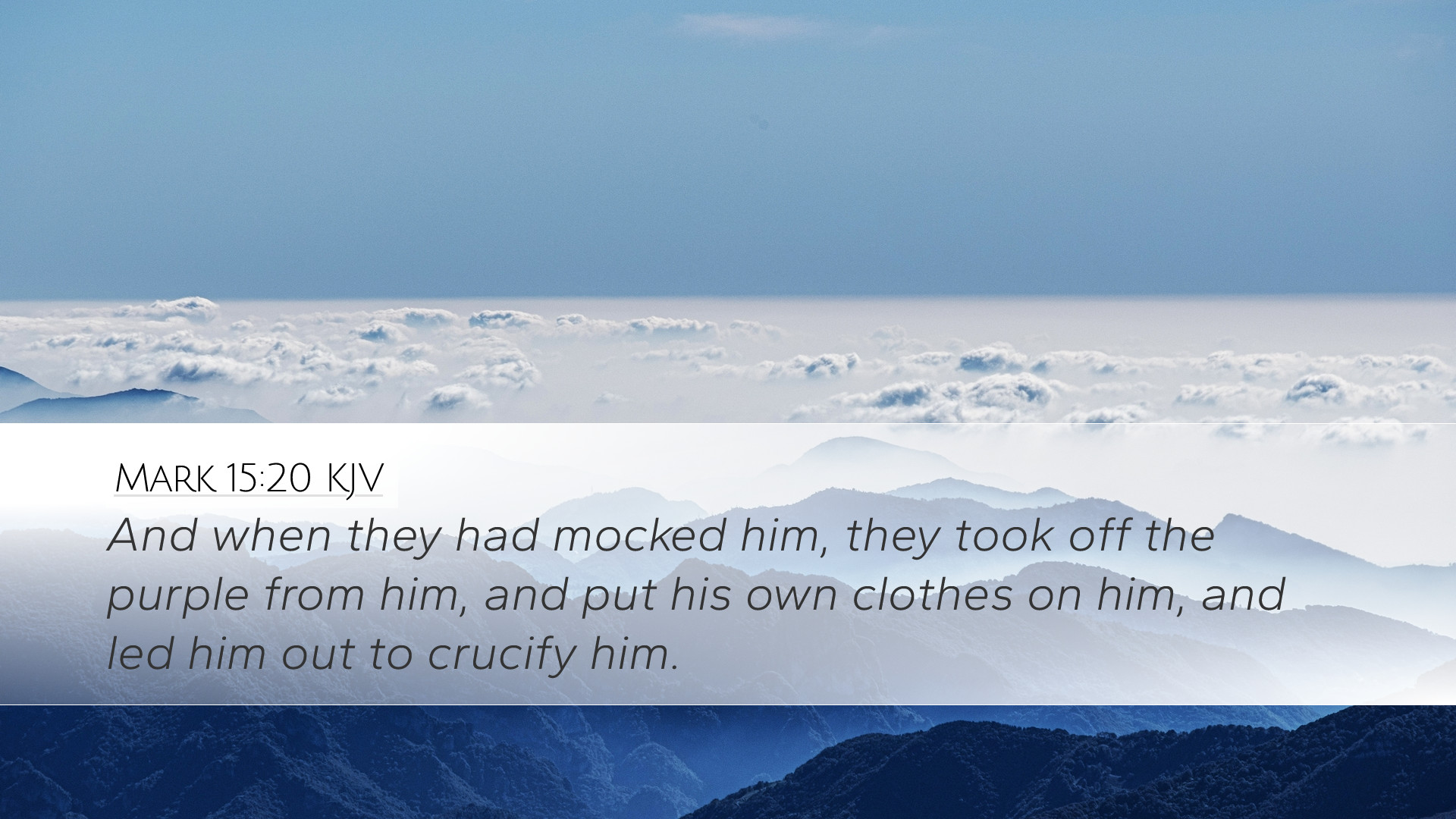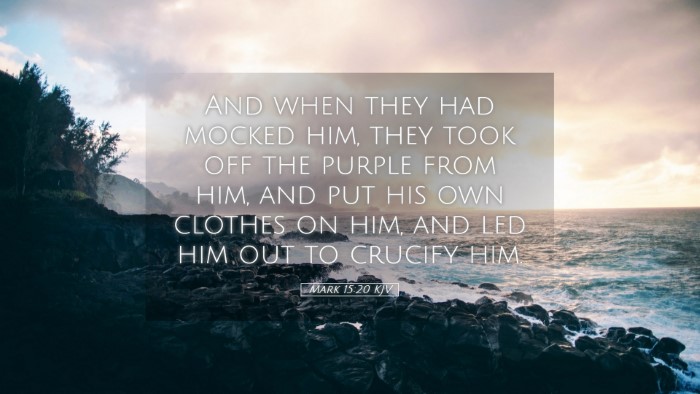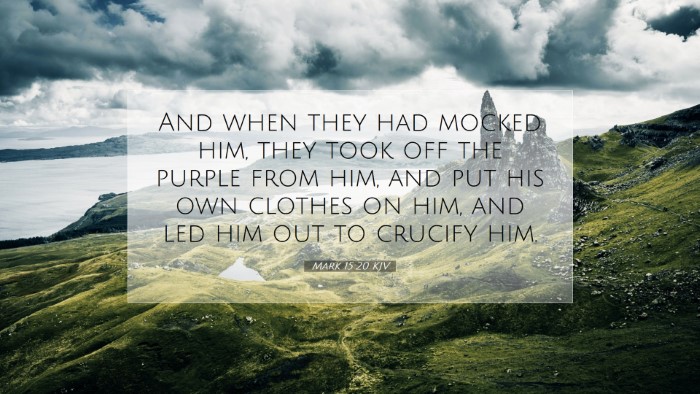Commentary on Mark 15:20
Verse: "And when they had mocked him, they took off the purple from him, and put his own clothes on him, and led him out to crucify him." (Mark 15:20)
Introduction
This verse encapsulates a moment of profound mockery and humiliation in the narrative of Jesus’ Passion. It reflects the cruelty of human sinfulness juxtaposed with the divine purpose of redemption. As we explore this verse, we draw from the reflections of respected public domain commentators such as Matthew Henry, Albert Barnes, and Adam Clarke.
The Context of the Mocking
Before analyzing the specifics of Mark 15:20, it is crucial to understand the surrounding events that lead to this moment. In the preceding verses, Jesus stands trial, accused by the chief priests and Roman authorities. His identity as the King of the Jews becomes a point of cruel mockery.
- Matthew Henry's Insight: Henry emphasizes that the mockery stems from a deep-seated rejection of Christ's kingship. The soldiers' actions—dressing Him in purple and placing a crown of thorns—satirize the notion of a suffering Messiah.
- Albert Barnes' Commentary: Barnes points out the irony in this mocking. Despite their derision, they inadvertently affirm Jesus’ true identity. The purple robe is suggestive of royal dignity, highlighting the stark contrast between Jesus' true status and their perception of Him.
- Adam Clarke's Observation: Clarke draws attention to the soldiers' disdain and the nature of mockery within the Roman context—reflecting both political arrogance and profound spiritual ignorance.
The Purple Robe and Its Significance
The purple robe signifies royalty, a direct irony as it is used to mock the true King. Each commentator provides a unique reflection on its meaning:
- Matthew Henry: Henry highlights that the purple attire symbolizes how earthly rulers often mock true righteousness. The soldiers, though powerful, serve as a reminder of humanity's folly in disregarding divine truth.
- Albert Barnes: Barnes considers the purple robe as a reflection of the expectation for a triumphant king, contrasting sharply with Jesus’ intended mission of suffering and servanthood.
- Adam Clarke: Clarke adds that the temporary elevation of Jesus in royal robes demonstrates the transient nature of worldly power. The soldiers’ mockery ultimately reveals their lack of understanding of the eternal Kingship of Christ.
Unclothing and Shame
Next, we see the removal of the purple robe and the subsequent dressing in His own clothes. This action speaks volumes about the nature of shame and the depths of humiliation:
- Matthew Henry: Henry remarks that stripping Jesus of the robe symbolizes the stripping away of all human respect. In His greatest moment of vulnerability, Jesus takes upon Himself the full weight of human sin and shame.
- Albert Barnes: Barnes interprets the act of clothed and unclothed as a parallel to the events of Eden—the fall of man, the resulting shame, and the need for redemption.
- Adam Clarke: Clarke focuses on the indignity faced by Jesus, emphasizing how deeply such humiliation cuts to the heart of the sinfulness of man. It also serves as a foreshadowing of the greater spiritual reality—the nakedness of sin revealed in the light of holiness.
The Act of Leading Him Out
Finally, the verse concludes with the soldiers leading Jesus out to be crucified, a significant act laden with implications:
- Matthew Henry: Henry interprets the act of leading Jesus away as a final act of human disregard for the divine; however, he notes that Jesus willingly submits to this path, illustrating His obedience unto death.
- Albert Barnes: Barnes notes that this leading away signifies humanity’s rejection of Christ, yet it is simultaneously the fulfillment of God's sovereign plan for salvation through the sacrificial death of His Son.
- Adam Clarke: Clarke sees this as a pivotal moment in redemptive history. The act of leading Him out underscores the rejection He faced and serves to fulfill the prophecies regarding the suffering Messiah.
Theological Implications
The weight of Mark 15:20 lies not only in the narrative details but in its broader theological implications:
- Human Sinfulness: This verse serves as a stark reminder of the depravity that leads to the crucifixion of the Savior. The mockery and cruelty reflect the totality of human sin.
- The Sovereignty of God: Despite the actions of the soldiers, God’s purposes prevail. This moment, filled with shame and ridicule, is part of the divine narrative of redemption.
- The Suffering Servant: Mark 15:20 emphasizes the identity of Jesus as the Suffering Servant foretold by Isaiah. It is through this humiliation that true glory is achieved.
Conclusion
The events depicted in Mark 15:20 carry a weight of significance that resonates throughout Scripture and achieves profound theological insights. For pastors, students, theologians, and Bible scholars, this verse serves as a pivotal reflection on the nature of Christ’s humility, the seriousness of sin, and the sovereign plan of God.


